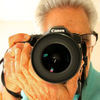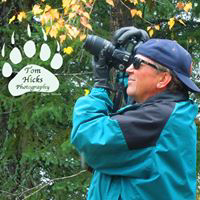Auto ISO
Jan 12, 2019 11:23:29 #
tomad
Loc: North Carolina
I almost always use auto ISO, but limit the minimum and maximum in camera at 100 and 800 respectively. I will occasionally go above 800 if necessary for a hand held low light situation but I've rarely liked those results.
I think it's fine to use auto if you set the minimum and maximum to stay in the "good results" range of your particular camera and lens.
It also depends on the type of photography you do. If you're primarily a landscape photographer then you usually have time to do all the settings manually to get the desired result, but if you'r a wildlife photographer you may not have the time. I photograph birds a lot and may quickly go from shooting a bird in a dark woods or swamp environment to shooting one flying overhead in a bright blue sky. In this situation you do not have time to change settings so having everything else under manual control but letting the camera select the ISO is the perfect way to go for me.
I think it's fine to use auto if you set the minimum and maximum to stay in the "good results" range of your particular camera and lens.
It also depends on the type of photography you do. If you're primarily a landscape photographer then you usually have time to do all the settings manually to get the desired result, but if you'r a wildlife photographer you may not have the time. I photograph birds a lot and may quickly go from shooting a bird in a dark woods or swamp environment to shooting one flying overhead in a bright blue sky. In this situation you do not have time to change settings so having everything else under manual control but letting the camera select the ISO is the perfect way to go for me.
Jan 12, 2019 11:29:32 #
Like others I have never once used Auto ISO. From using film cameras I have a pretty good idea of where my ISO should be set for the light conditions I might come across. Very seldom do I ever use over ISO 400. Usually my ISO is set at 200.
Dennis
Dennis
Jan 12, 2019 11:48:27 #
My response to the OPs question is that I would not use AUTO ISO in the situation proposed, which doesn't mean it can't be or shouldn't be used. When I use a long exposure time (slow shutter speed) I usually have something specific in mind, say fireworks or flowing water, and create a specific exposure for the situation. When shooting football under the lights, with a set Aperture and Shutter Speed, I find AUTO ISO welcome as it helps me adjust to light variances on the field. Never be afraid to experiment as experience is a very good teacher. Best of luck.
Jan 12, 2019 11:54:22 #
There are a couple reply’s staying I NEVER USE AUTO ISO. This strikes me as very close minded. There are some incredibly brilliant engineers developing this technology. I’m sure it has its use. I saw a recent pro suggesting it for sports action on a particular camera.
One question. If you NEVER use auto iso why have Auto focus, or Ap or Sp? Do you use those?
One question. If you NEVER use auto iso why have Auto focus, or Ap or Sp? Do you use those?
Jan 12, 2019 11:58:52 #
In that spirit, we don't need a wall either do we?
newvy wrote:
There are a couple reply’s staying I NEVER USE AUTO ISO. This strikes me as very close minded. There are some incredibly brilliant engineers developing this technology. I’m sure it has its use. I saw a recent pro suggesting it for sports action on a particular camera.
One question. If you NEVER use auto iso why have Auto focus, or Ap or Sp? Do you use those?
One question. If you NEVER use auto iso why have Auto focus, or Ap or Sp? Do you use those?
Jan 12, 2019 12:09:04 #
newvy wrote:
There are a couple reply’s staying I NEVER USE AUTO ISO. This strikes me as very close minded. There are some incredibly brilliant engineers developing this technology. I’m sure it has its use. I saw a recent pro suggesting it for sports action on a particular camera.
One question. If you NEVER use auto iso why have Auto focus, or Ap or Sp? Do you use those?
One question. If you NEVER use auto iso why have Auto focus, or Ap or Sp? Do you use those?
You are assuming way too much. I never said I don’t use auto focus or aperture or shutter priority. Nor did I see that from anyone else. But speaking for myself I use auto focus all the time except with my two Leica rangefinders. I use aperture priority for the most part but if the subject is moving I use shutter priority. Yes engineers have done a great job making exposures and focus foolproof. But those engineers have no idea what my preferences are when I take photographs.
I do not use Auto ISO because I don’t need to. I know what ISO to use. I prefer being in control of my camera. I also use Manual frequently when I feel I will get better photos such as when doing macro photography of insects or when photographing firearms and knives.
My preferences are not CLOSE(D) minded but more, what works for me. I suspect you use what works for you. That is being knowledgeable and intelligent.
Dennis
Jan 12, 2019 13:00:42 #
rbmitch123 wrote:
In taking a long exposure photo, say 2 seconds, would you ever keep your camera on auto ISO? Most cases I am shooting with Aperture priory and Auto ISO. For this discussion I would be shooting a landscape photo at dusk or in the dark.
For long exposures it's really unnecessary...select a fixed ISO in A or S mode. I've been experimenting with auto ISO (in M mode - fixed f and s) for BIF photography but I am leaning away from it I rather select an ISO that is in the ballpark and use either S or A modes. Also I found out that auto ISO can slow down the fps in Ch mode so another reason for me to avoid it, but it does have it's uses.
Jan 12, 2019 13:04:05 #
foxfirerodandgun wrote:
......I've been told that aperture settings only affect DOF and not exposure.....
Nooo!
 . Aperture is one of the three variables in the exposure triangle. Wider aperture (lower f-stop) = more light; narrower aperture (higher f-stop) = less light.
. Aperture is one of the three variables in the exposure triangle. Wider aperture (lower f-stop) = more light; narrower aperture (higher f-stop) = less light. If you are using manual + auto ISO you can select an appropriate aperture (the widest aperture that still gives you sufficient DOF) and then use just one adjustment wheel to play off shutter speed against ISO. There's no problem about the camera choosing inappropriate values because you are controlling everything. If you think the camera might be making an inappropriate choice of exposure you can dial in some exposure compensation and then proceed as normal.
Jan 12, 2019 13:11:23 #
amfoto1
Loc: San Jose, Calif. USA
rbmitch123 wrote:
In taking a long exposure photo, say 2 seconds, would you ever keep your camera on auto ISO? Most cases I am shooting with Aperture priory and Auto ISO. For this discussion I would be shooting a landscape photo at dusk or in the dark.
For one, I would NEVER use Aperture Priority AE in conjunction with Auto ISO. That makes no sense to me and I've tried but can't conceive of any reason to ever use "double auto exposure".
I ONLY use Auto ISO with Manual (which makes it another AE mode, it's no longer "manual").
For really long exposures... 2 seconds and up... I'd almost always switch to fully Manual mode. No Aperture Priority, no Auto ISO, no auto anything. With long exposures any AE mode will want to excessively lighten a long dusk or night time exposure. That will cause very high ISO and/or extra long exposures to be used.... and images will almost certainly end up much "noisier" than necessary. I'd have to dial in a lot of minus exposure compensation to make an AE mode work for night shots... And in my opinion it's easier to just shoot in fully manual mode.
NOTE: I am not a "strictly Manual" shooter. I think that's silly. I DO use Auto ISO with M AE sometimes, as well as Aperture Priority AE and Shutter Priority AE at other times. Probably use Aperture Priority AE the most. I definitely use Program AE the least....it's sort of my "snapshot" mode. The others are my "photograph" modes and I choose among them depending upon the shooting situation and what I need to control to accomplish the images I want to make.
Jan 12, 2019 13:12:32 #
You are right. In Auto ISO you are still in control of the three variables. I must Also say that MANUAL Auto ISO is the way to go. On that Steve Perry would agree I'm sure. How can the purists Manual shooters out there disagree on Auto ISO when it involves Manual? I guess, the same way we are having cognitive dissonance over protecting our borders.
R.G. wrote:
Nooo! img src="https://static.uglyhedgehog.com/im... (show quote)
Jan 12, 2019 13:27:09 #
Jan 12, 2019 13:43:53 #
Fotoartist wrote:
You are right. In Auto ISO you are still in control of the three variables. I must Also say that MANUAL Auto ISO is the way to go. On that Steve Perry would agree I'm sure. How can the purists Manual shooters out there disagree on Auto ISO when it involves Manual? I guess, the same way we are having cognitive dissonance over protecting our borders.
That is the second time in a couple of posts that you have brought up the wall. Are you trying to get this post moved to the attic? Many of us are more than willing to discuss this with you in the appropriate forum but why must you twice bring it up here. Go to The Attic, start your own post, The Wall is Stupid. See what you get for replies.
Dennis
Jan 12, 2019 13:45:49 #
Fotoartist wrote:
You are right. In Auto ISO you are still in control of the three variables. I must Also say that MANUAL Auto ISO is the way to go. On that Steve Perry would agree I'm sure. How can the purists Manual shooters out there disagree on Auto ISO when it involves Manual? I guess, the same way we are having cognitive dissonance over protecting our borders.
I agree with you..in M with auto ISO you still control all variables. One, at least for me, important setting is to show ISO instead of shutter count in the viewfinder. If ISO is too high (or too low) you simply adjust shutter time or aperture with one of the command dials while watching the ISO. You have total control!
You also can use exposure compensation, which in this situation changes ISO. Very easy to do in my opinion!
Jan 12, 2019 13:46:19 #
Linda From Maine wrote:
You could, as a way to get a ballpark exposure. Se... (show quote)
Precisely - auto ISO is great until it isn't... good advice, Linda! ;-)
Jan 12, 2019 13:48:12 #
If you want to reply, then register here. Registration is free and your account is created instantly, so you can post right away.








